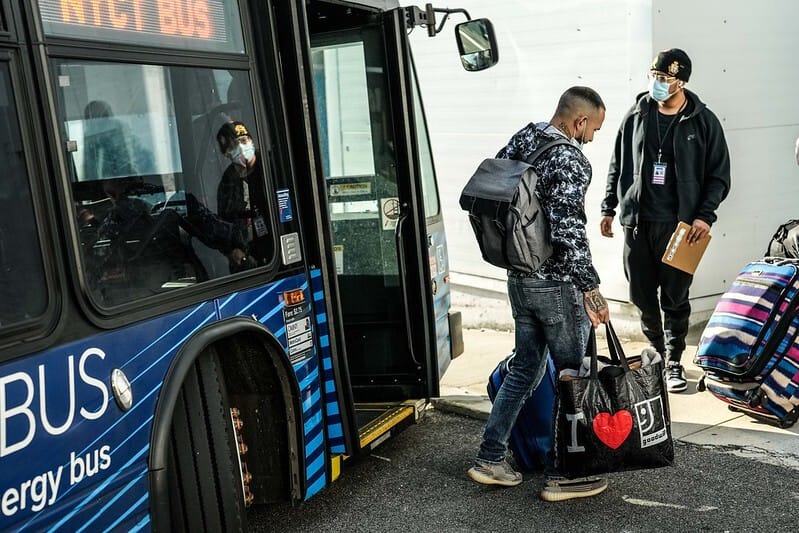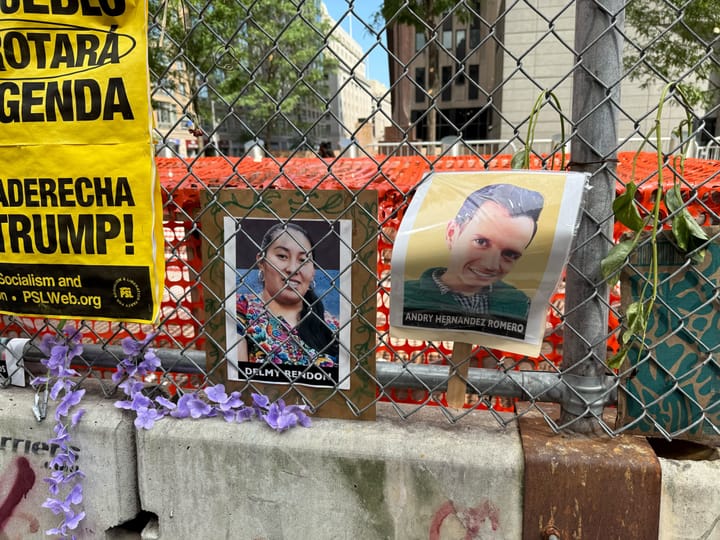The border bill New York officials loved may be dead, but it looms large over the 2024 election
Introducing the Groove's new immigration column.

Hello New York Groove readers (Groovers?), this is Gaby De Valle and Felipe De La Hoz. You may know us from our immigration policy newsletter BORDER/LINES, but for those of you who don’t, we’re both longtime immigration beat reporters who’ve written for years about immigration policy and practice, only to see very senior figures in politics and media continuously get the most basic facts and history completely wrong.
With immigration having already become a major issue in the November elections, and having to some extent dominated NYC headlines for the past year-and-a-half, we’re starting a periodic column here to delve into some of the actual specifics of how these systems work and dispel the misinformation that keeps piling up. Read along and we can all but guarantee you’ll end up better informed on the complexities of this issue than our own mayor and a good chunk of local, state, and federal legislators (unfortunately).
If, four years ago, you had told us that Democrats would be frothing at the mouth to pass legislation limiting asylum at the border, only to be stymied by Republicans, we probably wouldn’t have believed you. But that’s exactly what happened with the so-called “bipartisan border deal.”
Amid the fallout, some Democrats have begun chastising Republicans for putting party over country and, in doing so, failing to “secure the border.” Among them is our illustrious governor Kathy Hochul, who recently claimed that conservatives “broke” the border.
“It was gift wrapped,” Hochul said of the bill earlier this month. “You could have helped solve this problem.” Eric Adams, meanwhile, joined a chorus of mayors who denounced the vote, and urged the federal government to fund “cities that are impacted” by the migrant crisis.
Despite Hochul, Adams, and other Democrats’ crowing about how much the “border deal” would’ve helped New York, there are few provisions that would have done much. The state and city governments would not have been refunded for housing asylum seekers in hotels and other shelters, nor would they have gotten funding to do so in the future. (The bill did, however, provide FEMA funding to “State, local, Tribal, and Territorial law enforcement agencies to jointly enhance security along” land and water borders.)
The border bill may be dead, but its specter will likely continue to haunt us for months. Hochul’s comments suggest that she and other Democrats will use the bill’s demise as a cudgel in this year’s elections. But if you look at what the bill text actually says, it becomes pretty clear that it would’ve done very little to alleviate the city’s ongoing migrant crisis.
That’s not to say the bill wouldn’t have affected New York at all—it would have, primarily by limiting the number of migrants who end up here thanks to two provisions in the agreement that simply shut tens of thousands of people out of the asylum process altogether. To help you get a sense of how the bill would — and wouldn’t — have affected New York, we read the entire thing and pulled out the most important parts.
The border
One of the most far-reaching provisions in the bill would be giving the Department of Homeland Security the power to implement a “border emergency authority,” in effect shutting down asylum processing at the border, any time the seven-day average of migrants encountered at the border was between 4,000 and 5,000 people per day. The bill would have also required the emergency authority to go into effect any time the seven-day average exceeded 5,000, or if single-day encounters exceeded 8,500.
Since New York has become one of the top destinations for asylum seekers, this would have stemmed the flow of people to the city—at least temporarily. As past measures to limit asylum like Title 42 and the Remain in Mexico policy have shown, attempts to stop migrants from claiming asylum at the border have two effects: they create bottlenecks at ports of entry, and, when people tire of waiting weeks or months to go through the appropriate channels, they instead try crossing through the desert, often risking their lives in the process.
Another big change would be to the standards for qualifying for asylum eligibility in the first place. The bill would replace the current standard of proving “significant possibility” of persecution under the current so-called credible fear standard — the first step to get an asylum case underway as opposed to being immediately removed — with “reasonable possibility,” as well as specifically incorporate an analysis on whether someone could have relocated within their own country of origin.
This doesn’t seem like much of a change at all, but in practice it would raise the evidentiary standard to qualify for asylum, and allow people who don’t meet it to become immediately deportable. In tandem with the Title 42-like policy that can be triggered, the upshot would be that significantly fewer people would be making it past the border itself, and ending up in the city.
The courts
The deal would have also allocated $404 million to the Executive Office for Immigration Review, the agency within the Department of Justice that oversees the immigration court system, to hire new judges in an attempt to tackle the backlog of cases, which surpassed 3 million last December. There are six immigration courts in New York state, three of which are in the city. New York City-area immigration courts reported 80,042 new filings between March and August of last year—more than anywhere else in the country.
To further alleviate the strain on the immigration court system, the bill also would have established “provisional noncustodial removal proceedings.” Unlike current defensive asylum cases that play out over months or years in the Justice Department immigration courts, this process would have taken place entirely within Homeland Security’s U.S. Citizenship and Immigration Services, the entity that processes immigration applications like visas and residency (and asylum applications that are not made defensively).
Applicants would be interviewed by an asylum officer who could grant them asylum immediately, with supervisory approval, send them to a more involved merits hearing, or deny them outright. In cases of denials, asylum seekers could appeal to a newly-created Protection Appellate Board, which would consist of panels of three asylum officers within USCIS, which would have the final word; no sending it to the immigration courts (unaccompanied minors would be exempted from this).
The day-to-day
Perhaps one of the most significant planks for NYC is that, although clearing the first hurdle in a defensive asylum case would have gotten harder, those who cleared it would have received immediate work authorization. As you’ve probably heard plenty so far, from the mayor and others, migrants can’t even apply for work authorization until their asylum application has been pending for 150 days, and most people aren’t able to file their official asylum applications until weeks or months after crossing the border. Migrants’ inability to legally work is one of the most substantial impediments to their self-sufficiency in New York City and elsewhere.
Under the bill, applicants who were released from custody and received a so-called positive protection determination would have been granted work permission immediately (except for the cases where the government failed to interview them within the 90-day timeframe, in which case they could have gotten authorization only 30 days after applying for asylum). It’s worth noting these are legal and not logistical timeframes, and we would still expect that it would take USCIS some time, perhaps months, to process and send the authorization cards themselves, but nonetheless it would’ve been be much likelier that migrants would arrive in NYC either with permits in hand or with pending applications.
The politics
But it now seems like President Biden, under pressure from blue-state Democrats like Hochul and Adams, is considering issuing some of the same restrictions, like raising the credible fear standard, via executive order. Local politicians will keep exerting pressure, probably often without understanding what’s really on the table. Not that there aren’t real things the federal government could do to intervene on migrant arrivals that would substantively take the pressure off cities and states without adopting the right’s restrictionist framing; these range from simple case management assistance to a national resettlement program similar to the refugee system to increasing use of the parole program.
None of that, however, was in the bill. And yet Democrats, who just a few years ago were telling us voting for Biden would restore decency to our immigration system, are ready to embrace policies that are nearly indiscernible from Trump-era anti-immigration architect Stephen Miller’s wish list.
With Trump setting himself up to run his almost-certain GOP campaign for the presidency largely on the promise of some draconian silver-bullet immigration “fix” — to the point that the deal was killed largely on the basis of his desire to use it as an electoral issue — Biden is falling into the age-old trap of trying to out-conservative the famously sadistic xenophobe. Biden is no doubt doing so in response to polls showing that voters seem to trust Trump more than him on the issue, misreading it as a marker that he needs to get closer to Trump as opposed to staking out his own policy response.
As the election gets closer, the specter of this bill or the executive actions Biden seems to be planning will be deployed by Biden and his allies as proof positive that they’re doing their part to fix the issue. Voters should keep in mind what this actually means: a capitulation to GOP demands that would do little to help the blue localities and states demanding help, and much to entrench the restrictionist ideology that the president once loudly repudiated.




Comments ()